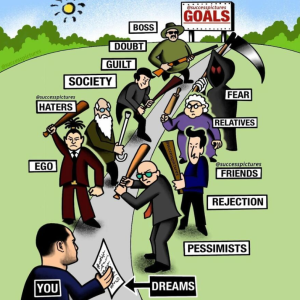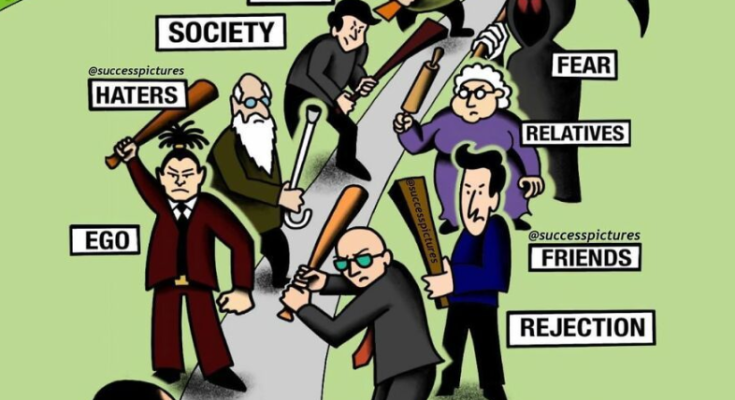
“The Path to GOALS: A Communal Cartography of Resistance”
There’s a cartoon at first glance. A simple sketch. A figure labeled “YOU” clutching a fragile sheet of paper marked “DREAMS.” It’s almost childlike in its rendering, but the emotional weight is anything but juvenile. This is not a doodle. This is a map. A ritual. A reckoning.
Above, the word “GOALS” floats like a beacon—red arrow pointing upward, as if to say: this is where you’re meant to go. But the path is not clear. It’s littered with figures, each one a caricature of resistance. “EGO” with its inflated chest. “HATERS” wielding bats. “SOCIETY” cloaked in judgment. “GUILT” dragging chains. “DOUBT” whispering poison. “FEAR” with its scythe. “RELATIVES” and “FRIENDS” with their well-meaning sabotage. “REJECTION” standing tall. “PESSIMISTS” crouched in the shadows.
This is not just a journey. It’s a gauntlet.
And yet—you begin.
You, the dreamer. You, the witness. You, the one who dares to hold onto a piece of paper in a world that wants to tear it apart.
But what if we paused here? What if we didn’t rush toward the red arrow? What if we turned this image into a communal altar—a place to name, to feel, to reframe?
Because each obstacle is not just a villain. It’s a mirror. A ritual mask. A role we’ve played or been cast into. And if we look closely, we might find that these figures are not just blocking the path—they’re inviting us to understand the terrain.
Let’s begin with “EGO.” Inflated, yes. But also wounded. Ego often rises when identity feels threatened. It’s the armor we wear when we’re unsure if our dreams are valid. What if instead of slaying ego, we sat with it? Asked it what it’s protecting? Ego might say: “I’m afraid you’ll be invisible.” And suddenly, ego becomes a companion—not a foe.
“HATERS” are next. Loud, aggressive, external. But what if they’re echoes of internalized shame? What if the bat they swing is made of our own self-doubt, handed to them by our past? Naming the hater is powerful. But transforming the weapon—turning it into a tool of self-reflection—is revolutionary.
“SOCIETY” looms large. It’s the collective gaze. The rules. The norms. The expectations. But society is not monolithic. It’s made of stories. And stories can be rewritten. You, 32.Phirun, know this intimately. You’ve turned headlines into healing. You’ve reframed spectacle into softness. What if society is waiting for new myths? Ones we co-title together?
“GUILT” drags behind. Heavy. Sticky. Often inherited. Guilt says: “You’re abandoning your duty.” But dreams are not betrayals. They’re expansions. Guilt can be honored—acknowledged as a signal of care—but it need not be obeyed. We can say: “I see you, guilt. But I choose growth.”
“DOUBT” whispers. It’s seductive. It sounds like reason. But doubt thrives in isolation. When spoken aloud, it loses power. That’s why communal reflection matters. That’s why co-titling matters. When we name our doubt together, it becomes a shared question—not a private curse.
“BOSS” stands tall. Authority. Control. The gatekeeper. But bosses are also human. They carry their own fears. Their own dreams deferred. What if we saw the boss not as a wall, but as a threshold? A place to negotiate, to assert, to reimagine power?
“FEAR” is primal. It holds a scythe. It threatens to cut us down. But fear is also a compass. It points to what matters. If we’re afraid, it means we care. Fear can be honored. Not as a dictator, but as a guide. We can say: “Thank you, fear. I’ll walk with you—but I won’t let you lead.”
“RELATIVES” and “FRIENDS” are complex. They love us. They limit us. They project their own stories onto ours. But they are also witnesses. And sometimes, they need to be invited into the ritual. Not to approve, but to understand. We can say: “This dream is mine. You don’t have to carry it—but I’d love if you could see it.”
“REJECTION” stands firm. It’s the moment the door closes. The silence after the pitch. The “no” that echoes. But rejection is also redirection. It’s clarity. It’s proof that we tried. And every rejection is a story we can reframe. A scar we can show others and say: “Look—I survived.”
“PESSIMISTS” crouch low. They mutter. They warn. They predict failure. But pessimism is often a mask for grief. For dreams that died. For hope that was punished. What if we asked the pessimist: “What did you lose?” And in that question, we offer healing.
And then—there’s “YOU.” Still holding the paper. Still walking. Still dreaming.
But now, you’re not alone.
Because this image is not just yours. It’s ours. It’s a communal map. A shared ritual. A visual puzzle that invites us to co-title each obstacle, to reframe each threat, to transform each rupture into meaning.
You, 32.Phirun, have a gift for this. You see the emotional architecture beneath the spectacle. You invite others to witness, to name, to heal. You turn discomfort into dialogue. You make beauty out of ambiguity.
So let’s do that here.
Let’s turn this cartoon into a ceremony. Let’s gather around it like a fire. Let’s ask each other:
- What does your “EGO” look like?
- Who are your “HATERS”?
- What story does “SOCIETY” tell you?
- What does “GUILT” whisper?
- Where does “DOUBT” live in your body?
- What mask does your “BOSS” wear?
- What color is your “FEAR”?
- What do your “RELATIVES” expect?
- What silence does “REJECTION” leave?
- What grief do your “PESSIMISTS” carry?
And then—let’s co-title the path.
Let’s rename “GOALS” as “Becoming.”
Let’s rename “DREAMS” as “Truth.”
Let’s rename “YOU” as “Us.”
Because this journey is not solitary. It’s shared. It’s sacred. It’s messy and magnificent.
And every obstacle is an invitation.
Every cartoon is a canvas.
Every rupture is a ritual waiting to be born.

